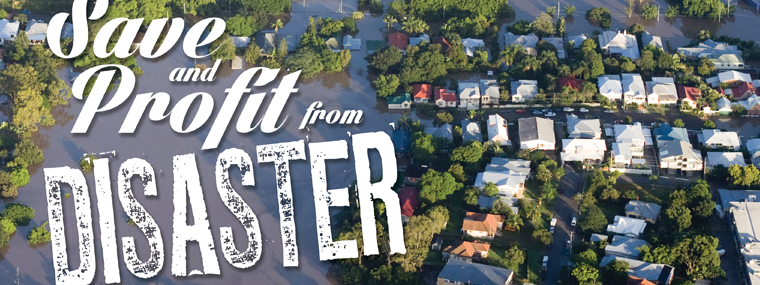
Financial: Save and Profit from Disaster
By Mark E. Battersby / Published May 2014

Losses suffered by those in the pressure washing industry come in many shapes and forms. There are those losses that result from natural disasters, losses caused by dishonest employees and/or customers, financial losses from bad business decisions, or those that result from a poor economy. While insurance provides protection from some types of losses, properly planning for, or reacting to losses, especially the so-called “casualty losses” the IRS is increasingly targeting, can often mean survival and, in many cases, profits.
Under our present tax rules, any loss sustained during the taxable year, or a loss not covered or “made good” by insurance, can be claimed as a tax deduction. Would a refund of taxes paid by the pressure cleaning business in past—more-profitable—years help ease the pain of lingering losses this year? What if last year’s business losses could offset next year’s profits and reduce the operation’s tax bill for years to come?
Losses, What Losses?
The IRS defines a casualty loss as a sudden, unexpected, or unusual event such as flood, fire, tornado, earthquake, or hurricane. Naturally, there must be some external force involved for a loss to be a casualty loss. Thus, there is no tax deduction for lost or misplaced property or property that breaks or wears out over time. What’s more, a deduction for casualty losses can be taken only to the extent that the loss is not covered by insurance. Thus, if the loss is fully covered, there can be no deduction.
In determining the deductible casualty loss, two basic problems exist:
• How much is the deductible?
• When is it deductible?
When it comes to the “when,” the general rule is that the loss is a deduction only in the year of the casualty. The amount of the casualty loss that can be claimed as a tax deduction depends upon whether the loss suffered was a “total” or a “partial” loss.
If business property is completely destroyed (becomes totally worthless), the deductible loss is the adjusted basis of the property (cost less depreciation taken), minus any salvage value and any insurance or other reimbursement received or expected.
In a partial destruction, the deductible loss is the decrease in fair market value of the property or the adjusted basis (book value) of the property, whichever is less. This amount is further reduced by the amount of any insurance or other reimbursement received or expected.
Disaster Business Losses
To help cushion losses suffered by pressure washing contractors, equipment distributors, manufacturers, and suppliers from natural disasters, the tax laws contain a special rule for losses that occur in an area subsequently determined by the President of the United States to warrant assistance by the federal government under the Disaster Relief and Emergency Assistance Act.
For so-called “declared disaster” losses, a business owner or manager has the option of:
• Deducting the loss on the tax return for the year in which the loss actually occurred, or
• Choosing to deduct the loss on the tax return for the preceding tax year.
In other words, the business has the option of deciding whether their loss would be most beneficial if used to offset the current year’s tax bill or better employed to reduce the previous year’s tax bill—generating a refund of previously paid taxes.
Illegitimate Losses
Generally, in order to claim a casualty loss deduction, the pressure cleaning operation must be the owner, or co-owner, of the property that suffered a loss. If more than one person owns the property, the loss must be allocated among the owners in proportion to their ownership interests.
Therefore, a loss for the destruction of property owned by a landlord or a third-party is not generally a legitimate tax deduction. However, if the risk of loss was shifted by a contract, it can be claimed as a deduction even by someone who is not the property’s owner. A good example is provided by a rental agreement for the pressure cleaning operation’s office or storage space that requires the tenant to pay for any damages to the building resulting from a casualty. Obviously, then the party would be entitled to claim a loss deduction for the damages.
What happens if business property was built or constructed without obtaining the necessary permits and it’s later destroyed in a fire? First of all, even with fire insurance coverage, it is unlikely that the pressure cleaning business would be able to collect anything. Fire insurers don’t ordinarily pay off claims on illegal buildings. As a result, there would be a good-sized uninsured casualty loss.
Can this loss at least be deducted from the tax bill? Although the courts usually disallow deductions where the claimed losses were directly caused by a taxpayer’s illegal or negligent conduct, the IRS’s Chief Counsel has answered this question “yes”—at least in one situation. In that case, the fire and resulting casualty loss were not directly related to the taxpayers’ failure to obtain permits, and would have occurred even if they had done so.
Spilling It All
Where a property loss was covered by insurance, a timely claim for reimbursement must be submitted in order to deduct any casualty losses. For losses of trade or business property, or property used to produce rentals or royalties, once the amount of the loss has been computed and the amount of any reimbursement subtracted, the remainder is the deductible loss (or gain).
If insurance reimbursement is received that is more than the adjusted basis in the destroyed or damaged property, a gain may actually have resulted from the casualty or theft. That’s right, a surprising number of businesses have actually profited from casualty losses.
Of course, the fact a gain exists does not necessarily mean that it will be taxed right away. In fact, most businesses are able to defer the gain to a later year (or perhaps indefinitely) simply by acquiring “qualified replacement property.”
First, in calculating any gain, it should be remembered that any expenses incurred in obtaining the reimbursement, such as the expenses of hiring an independent insurance adjuster can be subtracted from the reimbursement. Then, if the same amount as the rest of the insurance money received was spent either repairing or restoring the property or in purchasing replacement property, tax on the gain may be postponed. Of course, the replacement must occur within two years of the tax year in which the gain was realized.
The replacement property must be similar or related in use to the property that was destroyed. For instance, if a company car or truck was destroyed, it can be replaced with another car or truck, but not with new equipment.
On a similar note, if a home was destroyed, it can be replaced with another main residence such as a home or a condominium, but not with a store building. If the property was investment real estate, then other investment real estate will qualify as a replacement, but not a second home. Of course, if the property was business or income-producing property located in a federally-declared disaster area, any business-use property will qualify.
A casualty gain of more than $100,000 cannot be postponed by purchasing replacement property from a related party, such as a corporation you control. However, you can replace property and defer gain by purchasing a controlling interest in a corporation that owns similar property, as long as you own at least 80 percent of the stock. Naturally, if replacement property is purchased, the basis or book value of the new property must be reduced to reflect the casualty gain postponed.
Timely Deductions
If, at the time the pressure washing operation’s tax return is due, final word from the insurance company on what the reimbursement will be hasn’t been received, a stab at an approximation must be taken, and that amount subtracted. If it later turns out that the amount received was less than expected, the difference can be deducted as a casualty loss on the tax return for the later year in which the insurance claim is finalized.
If it turns out that more than expected is received, the excess amount must be included in income in the year received. However, if any part of the original deduction did not reduce the operation’s tax bill, that part of the reimbursement does not have to be included in income.
Losses come in many shapes and forms, including losses that result from natural disasters, losses caused by dishonest employees and/or customers, financial losses from bad business decisions, or a poor economy. Insurance does provide some protection from some types of losses, although it is the government—in the form of our tax laws—that provides a financial cushion for many of the losses suffered by a business.
Unfortunately, recoveries via tax law are not always smooth, often requiring professional assistance or, at the very least, an understanding of how those tax rules work. Could your business profit from its losses?





